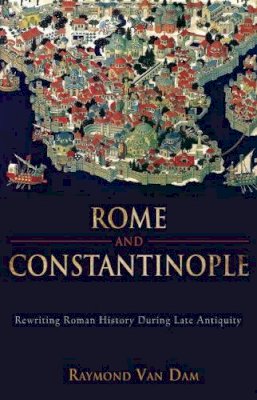
Stock image for illustration purposes only - book cover, edition or condition may vary.
Rome and Constantinople: Rewriting Roman History during Late Antiquity
Raymond Van Dam
€ 35.52
FREE Delivery in Ireland
Description for Rome and Constantinople: Rewriting Roman History during Late Antiquity
Hardback. Tracing the arc of empire from the Rome of Augustus to Justinian's Constantinople, this work shows how the changing political structures, ideologies, and historical narratives of Old and New Rome always remained rooted in the bedrock of the ancient Mediterranean's economic and demographic realities. Num Pages: 110 pages, maps. BIC Classification: 1QDAR; HBLA1; HRAX. Category: (G) General (US: Trade). Dimension: 223 x 149 x 14. Weight in Grams: 290.
Imperial Rome and Christian Constantinople were both astonishingly large cities with over-sized appetites that served as potent symbols of the Roman Empire and its rulers. Esteemed historian Raymond Van Dam draws upon a wide array of evidence to reveal a deep interdependence on imperial ideology and economy as he elucidates the parallel workaday realities and lofty images in their stories.
Tracing the arc of empire from the Rome of Augustus to Justinian's Constantinople, he masterfully shows how the changing political structures, ideologies, and historical narratives of Old and New Rome always remained rooted in the bedrock of the ancient Mediterranean's economic and demographic realities. The transformations in the Late Roman Empire, brought about by the rise of the military and the church, required a rewriting of the master narrative of history and signaled changes in economic systems. Just as Old Rome had provided a stage set for the performance of Republican emperorship, New Rome was configured for the celebration of Christian rule. As it came to pass, a city with too much history was outshone by a city with no history. Provided with the urban amenities and an imagined history appropriate to its elevated status, Constantinople could thus resonate as the new imperial capital, while Rome, on the other hand, was reinvented as the papal city.
Tracing the arc of empire from the Rome of Augustus to Justinian's Constantinople, he masterfully shows how the changing political structures, ideologies, and historical narratives of Old and New Rome always remained rooted in the bedrock of the ancient Mediterranean's economic and demographic realities. The transformations in the Late Roman Empire, brought about by the rise of the military and the church, required a rewriting of the master narrative of history and signaled changes in economic systems. Just as Old Rome had provided a stage set for the performance of Republican emperorship, New Rome was configured for the celebration of Christian rule. As it came to pass, a city with too much history was outshone by a city with no history. Provided with the urban amenities and an imagined history appropriate to its elevated status, Constantinople could thus resonate as the new imperial capital, while Rome, on the other hand, was reinvented as the papal city.
Product Details
Publisher
Baylor University Press United States
Number of pages
110
Format
Hardback
Publication date
2010
Condition
New
Weight
290g
Number of Pages
110
Place of Publication
Waco, United States
ISBN
9781602582019
SKU
V9781602582019
Shipping Time
Usually ships in 15 to 20 working days
Ref
99-8
About Raymond Van Dam
Raymond Van Dam is Professor of History at the University of Michigan. His most recent books include Becoming Christian: The Conversion of Roman Cappadocia and The Roman Revolution of Constantine. He lives in Ann Arbor.
Reviews for Rome and Constantinople: Rewriting Roman History during Late Antiquity
"An expansive and daring book about the complexity of the human project, its possibilities, its limitations, and its inscrutable ambiguity."
Walter Brueggeman, Professor Emeritus, Columbia Theological Seminary
Walter Brueggeman, Professor Emeritus, Columbia Theological Seminary
